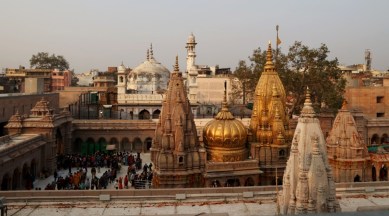Stay updated with the latest - Click here to follow us on Instagram
Project Varanasi: Eternal, with layers of history, maze of politics
🔴 To reporters on what had become the ‘Ayodhya beat’, Kashi and Mathura were ports of call, the disputes there linked to a movement gathering steam, changing politics, and the country.

On an October morning in 1990, hundreds packed the narrow lanes of Ayodhya, cheering men who had scaled the walls of the then disputed Ram Janmabhoomi-Babri Masjid site and raced to the domes, carrying a saffron flag. “Ayodhya toh sirf jhaanki hai, Kashi Mathura baaki hai (Ayodhya is a trailer, Kashi and Mathura still remain)” was their chant.
To reporters on what had become the ‘Ayodhya beat’, Kashi and Mathura were ports of call, the disputes there linked to a movement gathering steam, changing politics, and the country. The Babri Masjid’s days, you could tell, were numbered.
A little over 200 km away, Vishwanath Gali bustled with life. Shopkeepers called out to pilgrims, and self-styled guides promised a tour and darshan of Kashi Vishwanath for “whatever you think is right”.
Aware of the events unfolding in Ayodhya, a guide would lead pilgrims to a statue of Nandi staring in the direction of the adjacent Gyanvapi mosque. “Nandi always faces the Lord, so now you know where the real garbhagriha (sanctum sanctorum) is,” the guide would say to gasps and nods from those around him.
Kashi is timeless, more eternal than Rome, and ranks among the oldest continuously inhabited cities of the world. Lines that separate fact and fiction, history and myths, folklore and texts always get blurred here. So no one blamed the guides, or contested their accounts of how the temple at Kashi came into being, was destroyed, rebuilt over centuries.
To the devout, it is the holiest of places, one of the 12 jyotirlinga sites where Shiva appeared in his infinite form as a column of light with no beginning or end. Another account — and this finds mention in a petition on which a Varanasi court, in April this year, ordered an archaeological survey of the Kashi Vishwanath Temple-Gyanvapi Mosque complex, later stayed by the Allahabad High Court — says the temple has existed since time immemorial, and King Vikramaditya reconstructed it 2,050 years ago.
Most accounts say the temple was razed on the orders of Mughal Emperor Aurangzeb and the Gyanvapi mosque was built at the site in the 17th century.
Historian Audrey Truschke, in Aurangzeb: The Man and the Myth, too, notes: “Aurangzeb brought the bulk of Benares’s Vishvanatha Temple down in 1669. The temple had been built during Akbar’s reign by Raja Man Singh, whose great-grandson, Jai Singh, many believed had helped Shivaji and his son Sambhaji flee from the Mughal court in 1666… The Gyanvapi Masjid still stands today in Benares with part of the ruined temple’s wall incorporated into the building.”
The temple that is Kashi Viswanath today was built on an adjacent site in 1776-1780 by the Holkar ruler, Ahilyabai of Indore.
In 1991, as the Ayodhya temple movement picked pace, the Kashi Vishwanath-Gyanvapi dispute ended up in the courtroom. A suit sought restoration of the temple at the site where the Gyanvapi mosque stands. Fearful, Muslims filed petitions in the Allahabad High Court over the maintainability of the suit.
It was the year the P V Narasimha Rao government brought the Places of Worship (Special Provisions) Act which mandates that the nature of all places of worship, except the one in Ayodhya that was then under litigation, will be maintained as it was on August 15, 1947, and that no encroachment of any such place prior to the date can be challenged in courts.
The Act shielded Kashi and Mathura, but Babri Masjid was torn down a year later. To leaders of the Ram temple movement, the law was a stumbling block. The Supreme Court, in its November 2019 ruling on the Ram Janmabhoomi-Babri Masjid title suit which went in favour of the Hindu parties, called the Act “a legislative intervention which preserves non-retrogression as an essential feature of our secular values”.
But this March, nearly 30 years after its enactment, the Supreme Court sought the Centre’s response on a PIL challenging the constitutional validity of the Act.
Less than a month later, a Varanasi court, noting that “the matter in dispute pertains to have connection with our deep history”, ordered the Director General of Archaeological Survey of India to “get a comprehensive archaeological physical survey” done of the Kashi Vishwanath Temple-Gyanvapi Mosque complex and “find out as to whether the religious structure standing at present at the disputed site is a superimposition, alteration or addition or there is a structural overlapping of any kind, with or over, any religious structure”.
The judge rejected the argument that since “a mosque has been entered at the disputed site in the revenue records, hence the same is not open for challenge”.
In September, the Allahabad High Court stepped in. It stayed the Varanasi court order, saying a High Court “can interfere in order to keep the tribunals and Courts subordinate to it ‘within the bounds of their authority’” and “the Court below should wait for the verdict in the petitions pending before this Court and not to proceed further in the matter till the time a judgment is delivered”.